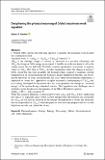Deciphering the physical meaning of Gibbs’s maximum work equation
Author(s)
Hanlon, Robert T.
Download10698_2024_Article_9503.pdf (653.1Kb)
Publisher with Creative Commons License
Publisher with Creative Commons License
Creative Commons Attribution
Terms of use
Metadata
Show full item recordAbstract
J. Willard Gibbs derived the following equation to quantify the maximum work possible for a chemical reaction
$${\text{Maximum work }} = \, - \Delta {\text{G}}_{{{\text{rxn}}}} = \, - \left( {\Delta {\text{H}}_{{{\text{rxn}}}} {-}{\text{ T}}\Delta {\text{S}}_{{{\text{rxn}}}} } \right) {\text{ constant T}},{\text{P}}$$
Maximum work
=
-
Δ
G
rxn
=
-
Δ
H
rxn
-
T
Δ
S
rxn
constant T
,
P
∆Hrxn is the enthalpy change of reaction as measured in a reaction calorimeter and ∆Grxn the change in Gibbs energy as measured, if feasible, in an electrochemical cell by the voltage across the two half-cells. To Gibbs, reaction spontaneity corresponds to negative values of ∆Grxn. But what is T∆Srxn, absolute temperature times the change in entropy? Gibbs stated that this term quantifies the heating/cooling required to maintain constant temperature in an electrochemical cell. Seeking a deeper explanation than this, one involving the behaviors of atoms and molecules that cause these thermodynamic phenomena, I employed an “atoms first” approach to decipher the physical underpinning of T∆Srxn and, in so doing, developed the hypothesis that this term quantifies the change in “structural energy” of the system during a chemical reaction. This hypothesis now challenges me to similarly explain the physical underpinning of the Gibbs–Helmholtz equation
$${\text{d}}\left( {\Delta {\text{G}}_{{{\text{rxn}}}} } \right)/{\text{dT}} = - \Delta {\text{S}}_{{{\text{rxn}}}} \left( {\text{constant P}} \right)$$
d
Δ
G
rxn
/
dT
=
-
Δ
S
rxn
constant P
While this equation illustrates a relationship between ∆Grxn and ∆Srxn, I don’t understand how this is so, especially since orbital electron energies that I hypothesize are responsible for ∆Grxn are not directly involved in the entropy determination of atoms and molecules that are responsible for ∆Srxn. I write this paper to both share my progress and also to seek help from any who can clarify this for me.
Date issued
2024-04-30Department
Massachusetts Institute of Technology. Department of Chemical EngineeringPublisher
Springer Science and Business Media LLC
Citation
Hanlon, R.T. Deciphering the physical meaning of Gibbs’s maximum work equation. Found Chem (2024).
Version: Final published version
ISSN
1386-4238
1572-8463